Beyond Food Processing: How Can We Sustainably Use Plant-Based Residues?
Abstract
1. Introduction
2. Bibliometric Analysis of Plant-Based Residues from the Agri-Food Sector
3. Biorefinery Strategies and Processing Technologies for the Valorization of Plant-Based Residues
3.1. Low-Energy and Non-Thermal Technologies for Biomass Fractionation
3.2. Green Solvents for the Extraction of Bioactive Compounds from Plant-Based Residues
3.2.1. Natural Deep Eutectic Solvents (NADESs)
| Biomass | Type of NADES | Target Compounds | Main Findings | Ref. |
|---|---|---|---|---|
| Orange peel waste | ChCl-based NADES composed of glycerol or ethylene glycol as hydrogen bond donors. | Polyphenols |
| [52] |
| Red grape pomace and olive leaves | Tailor-made ternary NADES composed of glycerol, citric acid, and L-proline | Polyphenols |
| [53] |
| Avocado residues | ChCl and betaine-based NADES paired with glycerol and organic acids/sugars | Phenolics |
| [54] |
| Blueberry pomace | ChCl-based NADES | Polyphenols, antho-cyanins |
| [55] |
| Apricot waste | ChCl/tartaric acid NADES | Phenolics, carotenoids |
| [56] |
| Olive oil processing waste | Sugar- and acid-based NADES | Phenolics |
| [57] |
| Spent coffee grounds | NADES composed of betaine/glycerol (1:3) (with water as a co-solvent) | Phenolic compounds and flavonoids |
| [58] |
| Blueberry peels | Sugar-based NADES | Polyphenols, anthocyanins |
| [59] |
| Purple araçá by-product | ChCl-based NADES | Phenolics |
| [60] |
| Herbs and agri-food wastes | Various NADESs | Phenolics |
| [61] |
3.2.2. Other Solvents Derived from Renewable Resources
3.3. Enzymatic and Microbial Processes for Lignin Degradation
3.4. Thermochemical Processing of Plant-Based Residues and By-Products
3.5. Multi-Product Recovery and Cascade Processing of Plant-Based Residues and By-Products
4. Future Perspectives
5. Conclusions
Supplementary Materials
Author Contributions
Funding
Data Availability Statement
Conflicts of Interest
Abbreviations
| MAPs | Medicinal and aromatic plants |
| HTC | Hydrothermal carbonation |
| DBD | Dielectric barrier discharge |
| DES | Deep eutectic solvent |
| NADES | Natural deep eutectic solvent |
| ChCl | Choline chloride |
| GHG | Greenhouse gas |
| LCA | Life cycle assessment |
| SSbD | Safe-and-sustainable-by-design |
References
- Falcon, W.P.; Naylor, R.L.; Shankar, N.D. Rethinking global food demand for 2050. Popul. Dev. Rev. 2022, 48, 921–957. [Google Scholar] [CrossRef]
- Tubiello, F.N.; Karl, K.; Flammini, A.; Gütschow, J.; Obli-Laryea, G.; Conchedda, G.; Pan, X.; Qi, S.Y.; Halldórudóttir Heiðarsdóttir, H.; Wanner, N.; et al. Pre- and Post-Production Processes Increasingly Dominate Greenhouse Gas Emissions from Agri-Food Systems. Earth Syst. Sci. Data 2022, 14, 1795–1809. [Google Scholar] [CrossRef]
- Food and Agriculture Organization of the United Nations. Available online: https://www.fao.org/faostat/en/#data/GT (accessed on 16 August 2025).
- Emissions Gap Report 2023: Broken Record|UNEP—UN Environment Programme. Available online: https://www.unep.org/interactives/emissions-gap-report/2023/ (accessed on 16 August 2025).
- Bentsen, N.; Felby, C.; Thorsen, B.J. Agricultural Residue Production and Potentials for Energy and Materials Services. Prog. Energy Combust. Sci. 2014, 40, 59–73. [Google Scholar] [CrossRef]
- Karan, S.K.; Hamelin, L. Crop Residues May Be a Key Feedstock to Bioeconomy but How Reliable Are Current Estimation Methods? Resour. Conserv. Recycl. 2021, 164, 105211. [Google Scholar] [CrossRef]
- Morya, R.; Andrianantenaina, F.H.; Singh, S.; Pandey, A.K.; Kim, G.B.; Verma, J.P.; Kumar, G.; Raj, T.; Kim, S.H. Exploring Rice Straw as Substrate for Hydrogen Production: Critical Challenges and Opportunities. Environ. Technol. Innov. 2023, 31, 103153. [Google Scholar] [CrossRef]
- Ungureanu, N.; Vlăduț, V.; Biriș, S. Ștefan Sustainable Valorization of Waste and By-Products from Sugarcane Processing. Sustainability 2022, 14, 11089. [Google Scholar] [CrossRef]
- Lubbe, A.; Verpoorte, R. Cultivation of Medicinal and Aromatic Plants for Specialty Industrial Materials. Ind. Crops Prod. 2011, 34, 785–801. [Google Scholar] [CrossRef]
- Yarin, T.; Dutta, B.; Murmu, D.; Medda, P.; Das, S. Valorization of Medicinal and Aromatic Plants Waste. J. Pharm. Innov. 2022, 11, 532–537. Available online: https://www.thepharmajournal.com/archives/?year=2022&vol=11&issue=1&ArticleId=10030 (accessed on 17 August 2025).
- Chen, S.L.; Yu, H.; Luo, H.M.; Wu, Q.; Li, C.F.; Steinmetz, A. Conservation and Sustainable Use of Medicinal Plants: Problems, Progress, and Prospects. Chin. Med. 2016, 11, 37. [Google Scholar] [CrossRef]
- Tao, W.; Jin, J.; Zheng, Y.; Li, S. Current Advances of Resource Utilization of Herbal Extraction Residues in China. Waste Biomass Valorization 2021, 12, 5853–5868. [Google Scholar] [CrossRef]
- Saha, A.; Basak, B.B. Scope of Value Addition and Utilization of Residual Biomass from Medicinal and Aromatic Plants. Ind. Crops Prod. 2020, 145, 111979. [Google Scholar] [CrossRef]
- Fernández-Sestelo, M.; Carrillo, J.M. Environmental Effects on Yield and Composition of Essential Oil in Wild Populations of Spike Lavender (Lavandula latifolia Medik.). Agriculture 2020, 10, 626. [Google Scholar] [CrossRef]
- Okello, C.; Pindozzi, S.; Faugno, S.; Boccia, L. Bioenergy Potential of Agricultural and Forest Residues in Uganda. Biomass Bioenergy 2013, 56, 515–525. [Google Scholar] [CrossRef]
- Ramesh, D.; Muniraj, I.K.; Thangavelu, K.; Karthikeyan, S. Chemicals and Fuels Production from Agro Residues: A Biorefinery Approach. In Sustainable Approaches for Biofuels Production Technologies. Biofuel and Biorefinery Technologies; Srivastava, N., Srivastava, M., Mishra, P., Upadhyay, S., Ramteke, P., Gupta, V., Eds.; Springer: Cham, Switzerland, 2018; Volume 7, pp. 47–71. [Google Scholar] [CrossRef]
- Tesfay, A.G.; Tesfay, A.H.; Adaramola, M.S. Quantifying Agricultural Residues Biomass Resources and the Energy Potentials with Characterization of Their Nature and Ethiopian Case Consumption Inference. Energies 2024, 17, 4736. [Google Scholar] [CrossRef]
- Bedoić, R.; Ćosić, B.; Duić, N. Technical Potential and Geographic Distribution of Agricultural Residues, Co-Products and by-Products in the European Union. Sci. Total Environ. 2019, 686, 568–579. [Google Scholar] [CrossRef]
- Hassoun, A.; Boukid, F.; Pasqualone, A.; Bryant, C.J.; García, G.G.; Parra-López, C.; Jagtap, S.; Trollman, H.; Cropotova, J.; Barba, F.J. Emerging Trends in the Agri-Food Sector: Digitalisation and Shift to Plant-Based Diets. Curr. Res. Food Sci. 2022, 5, 2261–2269. [Google Scholar] [CrossRef]
- EU Green Deal Guidance Note: Sustainable Agri-Food Systems|Knowledge for Policy. Available online: https://knowledge4policy.ec.europa.eu/publication/eu-green-deal-guidance-note-sustainable-agri-food-systems_en (accessed on 19 August 2025).
- Li, H.; Qu, Y.; Yang, Y.; Chang, S.; Xu, J. Microwave Irradiation—A Green and Efficient Way to Pretreat Biomass. Bioresour. Technol. 2016, 199, 34–41. [Google Scholar] [CrossRef]
- Mankar, A.R.; Pandey, A.; Modak, A.; Pant, K.K. Pretreatment of Lignocellulosic Biomass: A Review on Recent Advances. Bioresour. Technol. 2021, 334, 125235. [Google Scholar] [CrossRef]
- Abolore, R.S.; Jaiswal, S.; Jaiswal, A.K. Green and Sustainable Pretreatment Methods for Cellulose Extraction from Lignocellulosic Biomass and Its Applications: A Review. Carbohydr. Polym. Technol. Appl. 2024, 7, 100396. [Google Scholar] [CrossRef]
- More, T.T.; Ghangrekar, M.M. Improving Performance of Microbial Fuel Cell with Ultrasonication Pre-Treatment of Mixed Anaerobic Inoculum Sludge. Bioresour. Technol. 2010, 101, 562–567. [Google Scholar] [CrossRef] [PubMed]
- Wang, L.; Li, G.; Chen, X.; Yang, Y.; Liew, R.K.; Abo-Dief, H.M.; Lam, S.S.; Sellami, R.; Peng, W.; Li, H. Extraction Strategies for Lignin, Cellulose, and Hemicellulose to Obtain Valuable Products from Biomass. Adv. Compos. Hybrid. Mater. 2024, 7, 219. [Google Scholar] [CrossRef]
- Luo, J.; Fang, Z.; Smith, R.L. Ultrasound-Enhanced Conversion of Biomass to Biofuels. Prog. Energy Combust. Sci. 2014, 41, 56–93. [Google Scholar] [CrossRef]
- Djukić-Vuković, A.; Lazović, S.; Mladenović, D.; Knežević-Jugović, Z.; Pejin, J.; Mojović, L. Non-Thermal Plasma and Ultrasound-Assisted Open Lactic Acid Fermentation of Distillery Stillage. Environ. Sci. Pollut. Res. 2019, 26, 35543–35554. [Google Scholar] [CrossRef]
- Ma, Q.; Ji, Q.; Chen, L.; Zhu, Z.; Tu, S.; Okonkwo, C.E.; Out, P.; Zhou, C. Multimode Ultrasound and Ternary Deep Eutectic Solvent Sequential Pretreatments Enhanced the Enzymatic Saccharification of Corncob Biomass. Ind. Crops Prod. 2022, 188, 115574. [Google Scholar] [CrossRef]
- AlYammahi, J.; Hai, A.; Krishnamoorthy, R.; Arumugham, T.; Hasan, S.W.; Banat, F. Ultrasound-Assisted Extraction of Highly Nutritious Date Sugar from Date palm (Phoenix dactylifera) Fruit Powder: Parametric Optimization and Kinetic Modeling. Ultrason. Sonochem. 2022, 88, 106107. [Google Scholar] [CrossRef]
- Cano, R.; Pérez-Elvira, S.I.; Fdz-Polanco, F. Energy Feasibility Study of Sludge Pretreatments: A Review. Appl. Energy 2015, 149, 176–185. [Google Scholar] [CrossRef]
- Bagade, S.B.; Patil, M. Recent Advances in Microwave Assisted Extraction of Bioactive Compounds from Complex Herbal Samples: A Review. Crit. Rev. Anal. Chem. 2021, 51, 138–149. [Google Scholar] [CrossRef]
- Zhu, G.; Jin, D.; Zhao, L.; Ouyang, X.; Chen, C.; Qiu, X. Microwave-Assisted Selective Cleavage of CαCβ Bond for Lignin Depolymerization. Fuel Process. Technol. 2017, 161, 155–161. [Google Scholar] [CrossRef]
- Kumar, B.; Bhardwaj, N.; Agrawal, K.; Chaturvedi, V.; Verma, P. Current Perspective on Pretreatment Technologies Using Lignocellulosic Biomass: An Emerging Biorefinery Concept. Fuel Process. Technol. 2020, 199, 106244. [Google Scholar] [CrossRef]
- Mladenović, D.; Djukić-Vuković, A.; Veselinović, L.; Mijin, D.; Kocić-Tanackov, S.; Mojović, L. Short-Term Microwave-Assisted Peroxide Treatment for Intensified Lignin and Sugar Recovery from Corncob. Waste Biomass Valorization 2025, 16, 3909–3923. [Google Scholar] [CrossRef]
- Mladenović, D.; Grbić, J.; Đukić-Vuković, A.; Mijin, D.; Mojović, L. Lignin Removal from Corncob by Microwave-Coupled Peroxide Treatment. J. Process. Energy Agric. 2024, 28, 1–6. [Google Scholar] [CrossRef]
- Gan, P.; Zhang, K.; Xu, Q.; Zhao, Y.; Li, J.; Yang, G.; Zhang, Y.; Wang, Y.; Zhang, L.; Wang, B.; et al. Microwave-Assisted Choline Chloride/Lactic Acid Pretreatment for High-Efficiency Separation and Value-Added Utilization of Sugarcane Bagasse Components. Ind. Crops Prod. 2024, 220, 119251. [Google Scholar] [CrossRef]
- Kumar, A.; Škoro, N.; Gernjak, W.; Puač, N. Cold Atmospheric Plasma Technology for Removal of Organic Micropollutants from Wastewater—A Review. Eur. Phys. J. D 2021, 75, 283. [Google Scholar] [CrossRef]
- Anari, E.S.; Soltanizadeh, N.; Fathi, M. The Potential of DBD Plasma Pretreatment for the Isolation of Micro- and Nano-Cellulose Fibers from the Walnut Shells. Carbohydr. Polym. 2024, 327, 121692. [Google Scholar] [CrossRef]
- Zhu, H.; Han, Z.; Cheng, J.H.; Sun, D.W. Modification of Cellulose from Sugarcane (Saccharum officinarum) Bagasse Pulp by Cold Plasma: Dissolution, Structure and Surface Chemistry Analysis. Food Chem. 2022, 374, 131675. [Google Scholar] [CrossRef]
- Grbić, J.Z.; Mladenović, D.D.; Veljković, M.B.; Lazarević, S.S.; Lević, S.M.; Lazović, S.S.; Djukić-Vuković, A.P. Cold Plasma/Alkaline Pretreatment Facilitates Corn Stalk Fractionation and Valorization towards Zero-Waste Approach. Ind. Crops Prod. 2024, 222, 119498. [Google Scholar] [CrossRef]
- Grbić, J.; Mladenović, D.; Pavlović, S.; Lazović, S.; Mojović, L.; Djukić-Vuković, A. Advanced Oxidation Processes in the Treatment of Corn Stalks. Sustain. Chem. Pharm. 2023, 32, 100962. [Google Scholar] [CrossRef]
- Chemat, F.; Vian, M.A.; Cravotto, G. Green Extraction of Natural Products: Concept and Principles. Int. J. Mol. Sci. 2012, 13, 8615–8627. [Google Scholar] [CrossRef]
- Zhou, J.; Gullón, B.; Wang, M.; Gullón, P.; Lorenzo, J.M.; Barba, F.J. The Application of Supercritical Fluids Technology to Recover Healthy Valuable Compounds from Marine and Agricultural Food Processing By-Products: A Review. Processes 2021, 9, 357. [Google Scholar] [CrossRef]
- Fraguela-Meissimilly, H.; Bastías-Monte, J.M.; Vergara, C.; Ortiz-Viedma, J.; Lemus-Mondaca, R.; Flores, M.; Toledo-Merma, P.; Alcázar-Alay, S.; Gallón-Bedoya, M. New Trends in Supercritical Fluid Technology and Pressurized Liquids for the Extraction and Recovery of Bioactive Compounds from Agro-Industrial and Marine Food Waste. Molecules 2023, 28, 4421. [Google Scholar] [CrossRef] [PubMed]
- Herzyk, F.; Piłakowska-Pietras, D.; Korzeniowska, M. Supercritical Extraction Techniques for Obtaining Biologically Active Substances from a Variety of Plant Byproducts. Foods 2024, 13, 1713. [Google Scholar] [CrossRef] [PubMed]
- Ristivojević, P.; Krstić Ristivojević, M.; Stanković, D.; Cvijetić, I. Advances in Extracting Bioactive Compounds from Food and Agricultural Waste and By-Products Using Natural Deep Eutectic Solvents: A Circular Economy Perspective. Molecules 2024, 29, 4717. [Google Scholar] [CrossRef] [PubMed]
- Palos-Hernández, A.; Gutiérrez Fernández, M.Y.; Escuadra Burrieza, J.; Pérez-Iglesias, J.L.; González-Paramás, A.M. Obtaining Green Extracts Rich in Phenolic Compounds from Underexploited Food By-Products Using Natural Deep Eutectic Solvents. Opportunities and Challenges. Sustain. Chem. Pharm. 2022, 29, 100773. [Google Scholar] [CrossRef]
- Molnar, M.; Gašo-Sokač, D.; Komar, M.; Jakovljević Kovač, M.; Bušić, V. Potential of Deep Eutectic Solvents in the Extraction of Organic Compounds from Food Industry By-Products and Agro-Industrial Waste. Separations 2024, 11, 35. [Google Scholar] [CrossRef]
- Schuh, L.; Reginato, M.; Florêncio, I.; Falcao, L.; Boron, L.; Gris, E.F.; Mello, V.; Báo, S.N. From Nature to Innovation: The Uncharted Potential of Natural Deep Eutectic Solvents. Molecules 2023, 28, 7653. [Google Scholar] [CrossRef]
- Cannavacciuolo, C.; Pagliari, S.; Frigerio, J.; Giustra, C.M.; Labra, M.; Campone, L. Natural Deep Eutectic Solvents (NADESs) Combined with Sustainable Extraction Techniques: A Review of the Green Chemistry Approach in Food Analysis. Foods 2023, 12, 56. [Google Scholar] [CrossRef]
- Benítez-Correa, E.; Bastías-Montes, J.M.; Acuña-Nelson, S.; Muñoz-Fariña, O. Effect of Choline Chloride-Based Deep Eutectic Solvents on Polyphenols Extraction from Cocoa (Theobroma cacao L.) Bean Shells and Antioxidant Activity of Extracts. Curr. Res. Food Sci. 2023, 7, 100614. [Google Scholar] [CrossRef]
- Ozturk, B.; Parkinson, C.; Gonzalez-Miquel, M. Extraction of Polyphenolic Antioxidants from Orange Peel Waste Using Deep Eutectic Solvents. Sep. Purif. Technol. 2018, 206, 1–13. [Google Scholar] [CrossRef]
- Athanasiadis, V.; Palaiogiannis, D.; Poulianiti, K.; Bozinou, E.; Lalas, S.I.; Makris, D.P. Extraction of Polyphenolic Antioxidants from Red Grape Pomace and Olive Leaves: Process Optimization Using a Tailor-Made Tertiary Deep Eutectic Solvent. Sustainability 2022, 14, 6864. [Google Scholar] [CrossRef]
- Grisales-Mejía, J.F.; Cedeño-Fierro, V.; Ortega, J.P.; Torres-Castañeda, H.G.; Andrade-Mahecha, M.M.; Martínez-Correa, H.A.; Álvarez-Rivera, G.; Mendiola, J.A.; Cifuentes, A.; Ibañez, E. Advanced NADES-Based Extraction Processes for the Recovery of Phenolic Compounds from Hass Avocado Residues: A Sustainable Valorization Strategy. Sep. Purif. Technol. 2024, 351, 128104. [Google Scholar] [CrossRef]
- Zhang, X.J.; Liu, Z.T.; Chen, X.Q.; Zhang, T.T.; Zhang, Y. Deep Eutectic Solvent Combined with Ultrasound Technology: A Promising Integrated Extraction Strategy for Anthocyanins and Polyphenols from Blueberry Pomace. Food Chem. 2023, 422, 136224. [Google Scholar] [CrossRef] [PubMed]
- Koutsoukos, S.; Tsiaka, T.; Tzani, A.; Zoumpoulakis, P.; Detsi, A. Choline Chloride and Tartaric Acid, a Natural Deep Eutectic Solvent for the Efficient Extraction of Phenolic and Carotenoid Compounds. J. Clean. Prod. 2019, 241, 118384. [Google Scholar] [CrossRef]
- Bonacci, S.; Di Gioia, M.L.; Costanzo, P.; Maiuolo, L.; Tallarico, S.; Nardi, M. Natural Deep Eutectic Solvent as Extraction Media for the Main Phenolic Compounds from Olive Oil Processing Wastes. Antioxidants 2020, 9, 513. [Google Scholar] [CrossRef] [PubMed]
- Tzani, A.; Lymperopoulou, T.; Pitterou, I.; Karetta, I.; Belfquih, F.; Detsi, A. Development and Optimization of Green Extraction Process of Spent Coffee Grounds Using Natural Deep Eutectic Solvents. Sustain. Chem. Pharm. 2023, 34, 101144. [Google Scholar] [CrossRef]
- Alchera, F.; Ginepro, M.; Giacalone, G. Microwave-Assisted Extraction (MAE) of Bioactive Compounds from Blueberry by-Products Using a Sugar-Based NADES: A Novelty in Green Chemistry. LWT 2024, 192, 115642. [Google Scholar] [CrossRef]
- de Lima, N.D.; da Silva Monteiro Wanderley, B.R.; Andrade Ferreira, A.L.; Pereira-Coelho, M.; da Silva Haas, I.C.; Vitali, L.; dos Santos Madureira, L.A.; Müller, J.M.; Fritzen-Freire, C.B.; de Mello Castanho Amboni, R.D. Green Extraction of Phenolic Compounds from the By-Product of Purple Araçá (Psidium myrtoides) with Natural Deep Eutectic Solvents Assisted by Ultrasound: Optimization, Comparison, and Bioactivity. Food Res. Int. 2024, 191, 114731. [Google Scholar] [CrossRef]
- Hamieau, M.; Loulergue, P.; Szydłowska-Czerniak, A. Green Solvent Extraction of Antioxidants from Herbs and Agro-Food Wastes: Optimization and Capacity Determination. Appl. Sci. 2024, 14, 2936. [Google Scholar] [CrossRef]
- Mavai, S.; Bains, A.; Sridhar, K.; Chawla, P.; Sharma, M. Emerging Deep Eutectic Solvents for Food Waste Valorization to Achieve Sustainable Development Goals: Bioactive Extractions and Food Applications. Food Chem. 2025, 462, 141000. [Google Scholar] [CrossRef]
- Ciriminna, R.; Lomeli Rodriguez, M.; Demma Carà, P.; Lopez Sanchez, J.A.; Pagliaro, M. Limonene: A Versatile Chemical of the Bioeconomy. Chem. Commun. 2014, 50, 15288–15296. [Google Scholar] [CrossRef]
- Pagliaro, M.; Fabiano-Tixier, A.S.; Ciriminna, R. Limonene as a Natural Product Extraction Solvent. Green. Chem. 2023, 25, 6108–6119. [Google Scholar] [CrossRef]
- Sahad, N.; Som, A.M.; Baharuddin, A.S.; Mokhtar, M.N.; Busu, Z.; Sulaiman, A. Recovery of Residual Crude Palm Oil (RCPO) from Oil Palm Decanter Cake (OPDC) Using D-Limonene. Adv. Mat. Res. 2015, 1113, 405–410. [Google Scholar] [CrossRef]
- Akretche-K, S.; Ferhat, Z.; Amiali, M. Vegetable and Nut Oils Extraction by D-Limonene as Alternative Solvent. Int. J. Agric. Res. 2017, 12, 82–87. [Google Scholar] [CrossRef]
- Xu, J.; Peng, L.; Chu, J.; Shi, J.; Cui, Q.; Shi, Q. D-Limonene as an Alternative for the Extraction and Purification of Nuciferine from Lotus Leaf via Multi-Stage Vortex Assisted Two-Phase Solvent Extraction Integrated with Solid Phase Extraction Using Mesoporous Material SBA-15 as Adsorbent. Sustain. Chem. Pharm. 2023, 32, 100997. [Google Scholar] [CrossRef]
- Mourtzinos, I.; Anastasopoulou, E.; Petrou, A.; Grigorakis, S.; Makris, D.; Biliaderis, C.G. Optimization of a Green Extraction Method for the Recovery of Polyphenols from Olive Leaf Using Cyclodextrins and Glycerin as Co-Solvents. J. Food Sci. Technol. 2016, 53, 3939–3947. [Google Scholar] [CrossRef] [PubMed]
- Makris, D.P.; Passalidi, V.; Kallithraka, S.; Mourtzinos, I. Optimization of Polyphenol Extraction from Red Grape Pomace Using Aqueous Glycerol/Tartaric Acid Mixtures and Response Surface Methodology. Prep. Biochem. Biotechnol. 2016, 46, 176–182. [Google Scholar] [CrossRef]
- Trasanidou, D.; Apostolakis, A.; Makris, D.P. Development of a Green Process for the Preparation of Antioxidant and Pigment-Enriched Extracts from Winery Solid Wastes Using Response Surface Methodology and Kinetics. Chem. Eng. Commun. 2016, 203, 1317–1325. [Google Scholar] [CrossRef]
- Huamán-Castilla, N.L.; Mariotti-Celis, M.S.; Martínez-Cifuentes, M.; Pérez-Correa, J.R. Glycerol as Alternative Co-Solvent for Water Extraction of Polyphenols from Carménère Pomace: Hot Pressurized Liquid Extraction and Computational Chemistry Calculations. Biomolecules 2020, 10, 474. [Google Scholar] [CrossRef]
- Abdoun, R.; Grigorakis, S.; Kellil, A.; Loupassaki, S.; Makris, D.P. Process Optimization and Stability of Waste Orange Peel Polyphenols in Extracts Obtained with Organosolv Thermal Treatment Using Glycerol-Based Solvents. ChemEngineering 2022, 6, 35. [Google Scholar] [CrossRef]
- Shin, S.K.; Ko, Y.J.; Hyeon, J.E.; Han, S.O. Studies of Advanced Lignin Valorization Based on Various Types of Lignolytic Enzymes and Microbes. Bioresour. Technol. 2019, 289, 121728. [Google Scholar] [CrossRef]
- Grgas, D.; Rukavina, M.; Bešlo, D.; Štefanac, T.; Crnek, V.; Šikić, T.; Habuda-Stanić, M.; Landeka Dragičević, T. The Bacterial Degradation of Lignin—A Review. Water 2023, 15, 1272. [Google Scholar] [CrossRef]
- Andlar, M.; Rezić, T.; Marđetko, N.; Kracher, D.; Ludwig, R.; Šantek, B. Lignocellulose Degradation: An Overview of Fungi and Fungal Enzymes Involved in Lignocellulose Degradation. Eng. Life Sci. 2018, 18, 768. [Google Scholar] [CrossRef]
- Atiwesh, G.; Parrish, C.C.; Banoub, J.; Le, T.A.T. Lignin Degradation by Microorganisms: A Review. Biotechnol. Prog. 2022, 38, e3226. [Google Scholar] [CrossRef] [PubMed]
- Chen, M.; Li, Q.; Liu, C.; Meng, E.; Zhang, B. Microbial Degradation of Lignocellulose for Sustainable Biomass Utilization and Future Research Perspectives. Sustainability 2025, 17, 4223. [Google Scholar] [CrossRef]
- Saha, B.C.; Qureshi, N.; Kennedy, G.J.; Cotta, M.A. Biological Pretreatment of Corn Stover with White-Rot Fungus for Improved Enzymatic Hydrolysis. Int. Biodeterior. Biodegrad. 2016, 109, 29–35. [Google Scholar] [CrossRef]
- Wang, F.Q.; Xie, H.; Chen, W.; Wang, E.T.; Du, F.G.; Song, A.D. Biological Pretreatment of Corn Stover with Ligninolytic Enzyme for High Efficient Enzymatic Hydrolysis. Bioresour. Technol. 2013, 144, 572–578. [Google Scholar] [CrossRef]
- Sherpa, K.C.; Ghangrekar, M.M.; Banerjee, R. A Green and Sustainable Approach on Statistical Optimization of Laccase Mediated Delignification of Sugarcane Tops for Enhanced Saccharification. J. Environ. Manag. 2018, 217, 700–709. [Google Scholar] [CrossRef]
- Zhou, M.; Fakayode, O.A.; Ren, M.; Li, H.; Liang, J.; Yagoub, A.E.G.A.; Fan, Z.; Zhou, C. Laccase-Catalyzed Lignin Depolymerization in Deep Eutectic Solvents: Challenges and Prospects. Bioresour. Bioprocess. 2023, 10, 21. [Google Scholar] [CrossRef]
- Knežević, A.; Stajić, M.; Jovanović, V.M.; Kovačević, V.; Ćilerdžić, J.; Milovanović, I.; Vukojević, J. Induction of Wheat Straw Delignification by Trametes Species. Sci. Rep. 2016, 6, 26529. [Google Scholar] [CrossRef] [PubMed]
- Knežević, A.; Stajić, M.; Milovanović, I.; Vukojević, J. Wheat Straw Degradation by Trametes Gibbosa: The Effect of Calcium Ions. Waste Biomass Valorization 2018, 9, 1903–1908. [Google Scholar] [CrossRef]
- Matei, J.C.; Soares, M.; Bonato, A.C.H.; de Freitas, M.P.A.; Helm, C.V.; Maroldi, W.V.; Magalhães, W.L.E.; Haminiuk, C.W.I.; Maciel, G.M. Enzymatic Delignification of Sugar Cane Bagasse and Rice Husks and Its Effect in Saccharification. Renew. Energy 2020, 157, 987–997. [Google Scholar] [CrossRef]
- Su, Y.; Yu, X.; Sun, Y.; Wang, G.; Chen, H.; Chen, G. Evaluation of Screened Lignin-Degrading Fungi for the Biological Pretreatment of Corn Stover. Sci. Rep. 2018, 8, 5385. [Google Scholar] [CrossRef]
- Vasco-Correa, J.; Shah, A. Techno-Economic Bottlenecks of the Fungal Pretreatment of Lignocellulosic Biomass. Fermentation 2019, 5, 30. [Google Scholar] [CrossRef]
- Mei, J.; Shen, X.; Gang, L.; Xu, H.; Wu, F.; Sheng, L. A Novel Lignin Degradation Bacteria-Bacillus Amyloliquefaciens SL-7 Used to Degrade Straw Lignin Efficiently. Bioresour. Technol. 2020, 310, 123445. [Google Scholar] [CrossRef] [PubMed]
- Shah, T.A.; Lee, C.C.; Orts, W.J.; Tabassum, R. Biological Pretreatment of Rice Straw by Ligninolytic Bacillus Sp. Strains for Enhancing Biogas Production. Environ. Prog. Sustain. Energy 2019, 38, e13036. [Google Scholar] [CrossRef]
- Chen, J.; Cai, Y.; Wang, Z.; Wang, S.; Li, J.; Song, C.; Zhuang, W.; Liu, D.; Wang, S.; Song, A.; et al. Construction of a Synthetic Microbial Community for Enzymatic Pretreatment of Wheat Straw for Biogas Production via Anaerobic Digestion. Environ. Sci. Technol. 2024, 58, 9446–9455. [Google Scholar] [CrossRef]
- Olajuyigbe, F.M.; Fatokun, C.O.; Oyelere, O.M. Biodelignification of Some Agro-Residues by Stenotrophomonas Sp. CFB-09 and Enhanced Production of Ligninolytic Enzymes. Biocatal. Agric. Biotechnol. 2018, 15, 120–130. [Google Scholar] [CrossRef]
- Si, M.; Liu, D.; Liu, M.; Yan, X.; Gao, C.; Chai, L.; Shi, Y. Complementary Effect of Combined Bacterial-Chemical Pretreatment to Promote Enzymatic Digestibility of Lignocellulose biomass. Bioresour. Technol. 2019, 272, 275–280. [Google Scholar] [CrossRef]
- Shen, Z.; Zhang, K.; Si, M.; Liu, M.; Zhuo, S.; Liu, D.; Ren, L.; Yan, X.; Shi, Y. Synergy of Lignocelluloses Pretreatment by Sodium Carbonate and Bacterium to Enhance Enzymatic Hydrolysis of Rice Straw. Bioresour. Technol. 2018, 249, 154–160. [Google Scholar] [CrossRef]
- Amalina, F.; Razak, A.S.A.; Krishnan, S.; Sulaiman, H.; Zularisam, A.W.; Nasrullah, M. Biochar Production Techniques Utilizing Biomass Waste-Derived Materials and Environmental Applications—A Review. J. Hazard. Mater. Adv. 2022, 7, 100134. [Google Scholar] [CrossRef]
- Berenguer, C.V.; Perestrelo, R.; Pereira, J.A.M.; Câmara, J.S.; Kijevcanin, M.; Šoštari’c, T.Š.; Berenguer, C.V.; Perestrelo, R.; Pereira, J.A.M.; Câmara, J.S. Management of Agri-Food Waste Based on Thermochemical Processes towards a Circular Bioeconomy Concept: The Case Study of the Portuguese Industry. Processes 2023, 11, 2870. [Google Scholar] [CrossRef]
- Bioenergy—International Collaboration in Bioenergy. Available online: https://www.ieabioenergy.com/ (accessed on 24 August 2025).
- Funke, A.; Ziegler, F. Hydrothermal Carbonization of Biomass: A Summary and Discussion of Chemical Mechanisms for Process Engineering. Biofuels Bioprod. Biorefining 2010, 4, 160–177. [Google Scholar] [CrossRef]
- Reza, M.T.; Andert, J.; Wirth, B.; Busch, D.; Pielert, J.; Lynam, J.G.; Mumme, J. Hydrothermal Carbonization of Biomass for Energy and Crop Production. Appl. Bioenergy 2014, 1, 11–29. [Google Scholar] [CrossRef]
- Fang, J.; Zhan, L.; Ok, Y.S.; Gao, B. Minireview of Potential Applications of Hydrochar Derived from Hydrothermal Carbonization of Biomass. J. Ind. Eng. Chem. 2018, 57, 15–21. [Google Scholar] [CrossRef]
- Le, H.S.; Chen, W.-H.; Ahmed, S.F.; Said, Z.; Rafa, N.; Le, A.T.; Ağbulut, Ü.; Veza, I.; Nguyen, X.P.; Duong, X.Q.; et al. Hydrothermal Carbonization of Food Waste as Sustainable Energy Conversion Path. Bioresour. Technol. 2022, 363, 127958. [Google Scholar] [CrossRef] [PubMed]
- Pavkov, I.; Radojčin, M.; Stamenković, Z.; Bikić, S.; Tomić, M.; Bukurov, M.; Despotović, B. Hydrothermal Carbonization of Agricultural Biomass: Characterization of Hydrochar for Energy Production. Solid. Fuel Chem. 2022, 56, 225–235. [Google Scholar] [CrossRef]
- Nizamuddin, S.; Baloch, H.A.; Griffin, G.J.; Mubarak, N.M.; Bhutto, A.W.; Abro, R.; Mazari, S.A.; Ali, B.S. An Overview of Effect of Process Parameters on Hydrothermal Carbonization of Biomass. Renew. Sustain. Energy Rev. 2017, 73, 1289–1299. [Google Scholar] [CrossRef]
- Azaare, L.; Commeh, M.K.; Smith, A.M.; Kemausuor, F. Co-Hydrothermal Carbonization of Pineapple and Watermelon Peels: Effects of Process Parameters on Hydrochar Yield and Energy Content. Bioresour. Technol. Rep. 2021, 15, 100720. [Google Scholar] [CrossRef]
- Mannarino, G.; Sarrion, A.; Diaz, E.; Gori, R.; De la Rubia, M.A.; Mohedano, A.F. Improved Energy Recovery from Food Waste through Hydrothermal Carbonization and Anaerobic Digestion. Waste Manag. 2022, 142, 9–18. [Google Scholar] [CrossRef]
- Gupta, D.; Mahajani, S.M.; Garg, A. Investigation on Hydrochar and Macromolecules Recovery Opportunities from Food Waste after Hydrothermal Carbonization. Sci. Total Environ. 2020, 749, 142294. [Google Scholar] [CrossRef]
- Tran, T.H.; Le, H.H.; Pham, T.H.; Nguyen, D.T.; La, D.D.; Chang, S.W.; Lee, S.M.; Chung, W.J.; Nguyen, D.D. Comparative Study on Methylene Blue Adsorption Behavior of Coffee Husk-Derived Activated Carbon Materials Prepared Using Hydrothermal and Soaking Methods. J. Environ. Chem. Eng. 2021, 9, 105362. [Google Scholar] [CrossRef]
- Oh, J.I.; Lee, J.; Lee, T.; Ok, Y.S.; Lee, S.R.; Kwon, E.E. Strategic CO2 Utilization for Shifting Carbon Distribution from Pyrolytic Oil to Syngas in Pyrolysis of Food Waste. J. CO2 Util. 2017, 20, 150–155. [Google Scholar] [CrossRef]
- Carmona-Cabello, M.; Garcia, I.L.; Leiva-Candia, D.; Dorado, M.P. Valorization of Food Waste Based on Its Composition through the Concept of Biorefinery. Curr. Opin. Green. Sustain. Chem. 2018, 14, 67–79. [Google Scholar] [CrossRef]
- Kan, T.; Strezov, V.; Evans, T.J. Lignocellulosic Biomass Pyrolysis: A Review of Product Properties and Effects of Pyrolysis Parameters. Renew. Sustain. Energy Rev. 2016, 57, 1126–1140. [Google Scholar] [CrossRef]
- Singh, T.; Hussien, M.A.A.; Al-Ansari, T.; Saoud, K.; McKay, G. Critical Review of Solar Thermal Resources in GCC and Application of Nanofluids for Development of Efficient and Cost Effective CSP Technologies. Renew. Sustain. Energy Rev. 2018, 91, 708–719. [Google Scholar] [CrossRef]
- Azizi, K.; Keshavarz Moraveji, M.; Abedini Najafabadi, H. A Review on Bio-Fuel Production from Microalgal Biomass by Using Pyrolysis Method. Renew. Sustain. Energy Rev. 2018, 82, 3046–3059. [Google Scholar] [CrossRef]
- Papari, S.; Hawboldt, K. A Review on the Pyrolysis of Woody Biomass to Bio-Oil: Focus on Kinetic Models. Renew. Sustain. Energy Rev. 2015, 52, 1580–1595. [Google Scholar] [CrossRef]
- Aboagye, D.; Banadda, N.; Kiggundu, N.; Kabenge, I. Assessment of Orange Peel Waste Availability in Ghana and Potential Bio-Oil Yield Using Fast Pyrolysis. Renew. Sustain. Energy Rev. 2017, 70, 814–821. [Google Scholar] [CrossRef]
- Radojčin, M.; Bikić, S.; Pavkov, I.; Bukurov, M.; Despotović, B.; Stamenković, Z.; Oluški, N. Experimental Investigation on Thermophysical Properties of Iobiofluids. Adv. Mech. Eng. 2022, 14, 16878140221075457. [Google Scholar] [CrossRef]
- Bikić, S.; Radojčin, M.; Pavkov, I.; Bukurov, M.; Despotović, B.; Stamenković, Z.; Oluški, N.; Afif, R. Al Thermophysical Dispersion Properties of Agricultural Biomass Particles in Ethylene Glycol. Int. J. Thermofluids 2022, 16, 100226. [Google Scholar] [CrossRef]
- Tang, Y.; Huang, Q.; Sun, K.; Chi, Y.; Yan, J. Co-Pyrolysis Characteristics and Kinetic Analysis of Organic Food Waste and Plastic. Bioresour. Technol. 2018, 249, 16–23. [Google Scholar] [CrossRef] [PubMed]
- Zhang, H.; Chen, C.; Gray, E.M.; Boyd, S.E. Effect of Feedstock and Pyrolysis Temperature on Properties of Biochar Governing End Use Efficacy. Biomass Bioenergy 2017, 105, 136–146. [Google Scholar] [CrossRef]
- Liang, S.; Han, Y.; Wei, L.; McDonald, A.G. Production and Characterization of Bio-Oil and Bio-Char from Pyrolysis of Potato Peel Wastes. Biomass Convers. Biorefin 2015, 5, 237–246. [Google Scholar] [CrossRef]
- Rawat, S.; Wang, C.T.; Lay, C.H.; Hotha, S.; Bhaskar, T. Sustainable Biochar for Advanced Electrochemical/Energy Storage Applications. J. Energy Storage 2023, 63, 107115. [Google Scholar] [CrossRef]
- Aguado-González, L.; Sierra-Pérez, J.; Forte, C.; López-Forniés, I.; Blanc, S. Cascade Valorization of Hazelnut Industry By-Products for Industrial Use through Co-Creative Processes. J. Clean. Prod. 2025, 494, 144989. [Google Scholar] [CrossRef]
- Durán-Aranguren, D.D.; Yamakawa, C.K.; Ordeñana, J.; Sierra, R.; Posada, J.A.; Mussatto, S.I. An Experimental Cascade Biorefinery from Orange Residues: Sequential Recovery of Bioactive Compounds, Pectin, and Fermentation of Sugar-Rich Side Streams Using Conventional and Non-Conventional Yeasts. Biomass Bioenergy 2025, 193, 107514. [Google Scholar] [CrossRef]
- Chang, S.; Yun, C.; Yang, B.; Duan, J.; Chen, T.; Liu, L.; Li, B.; Guo, S.; Zhang, S. Comprehensive Reutilization of Glycyrrhiza uralensis Residue by Extrusion-Biological Pretreatment for Coproduction of Flavonoids, Cellulase, and Ethanol. Bioresour. Technol. 2024, 406, 131002. [Google Scholar] [CrossRef]
- Battista, F.; Zanzoni, S.; Strazzera, G.; Andreolli, M.; Bolzonella, D. The Cascade Biorefinery Approach for the Valorization of the Spent Coffee Grounds. Renew. Energy 2020, 157, 1203–1211. [Google Scholar] [CrossRef]
- Castilla-Archilla, J.; Cermeño, M.; Tuohy, M.; FitzGerald, R.J.; Lens, P.N.L. Fractionation of Brewer’s Spent Grain Using a Cascade Process for Carbohydrate Release and the Simultaneous Production of Protein and Fiber Fractions Targeting the Food Industry. ACS Sustain. Resour. Manag. 2024, 1, 2350–2360. [Google Scholar] [CrossRef]
- Muscat, A.; de Olde, E.M.; de Boer, I.J.M.; Ripoll-Bosch, R. The Battle for Biomass: A Systematic Review of Food-Feed-Fuel Competition. Glob. Food Secur. 2020, 25, 100330. [Google Scholar] [CrossRef]
- Brobbey, M.S.; Louw, J.; Görgens, J.F. A Techno-Economic and Life Cycle Assessment of Multiproduct Sugarcane Biorefinery: Lactic Acid as a Platform Chemical. Biomass Bioenergy 2025, 193, 107605. [Google Scholar] [CrossRef]
- Wang, Y.; Zhang, B.; Bao, J. Rigorous Calculation of Greenhouse Gases (GHG) in Sustainable l-Lactic Acid Production from Lignocellulosic Biomass Based on Advanced Biorefinery Processing Technology. ACS Sustain. Chem. Eng. 2025, 13, 6186–6196. [Google Scholar] [CrossRef]
- Kosamia, N.; Sanchez, A.; Rakshit, S. Scenario-Based Life Cycle Assessment and Environmental Monetary Valuation of Biosuccinic Acid Production from Lignocellulosic Biomass. Ind. Crops Prod. 2023, 202, 117101. [Google Scholar] [CrossRef]
- Winter, B.; Meys, R.; Bardow, A. Towards Aromatics from Biomass: Prospective Life Cycle Assessment of Bio-Based Aniline. J. Clean. Prod. 2021, 290, 125818. [Google Scholar] [CrossRef]
- Caldeira, C.; Garmendia, A.I.; Tosches, D.; Mancini, L.; Abbate, E.; Farcal, R.; Lipsa, D.; Rasmussen, K.; Rauscher, H.; Riego, S.J.; et al. Safe and Sustainable by Design Chemicals and Materials—Application of the SSbD Framework to Case Studies. European Commission. JRC Tech. Rep. 2023, JRC131878. [Google Scholar] [CrossRef]
- Fantke, P. Safe and Sustainable-by-Design (SSbD): Calling for Efficient Metrics, Biophysical Benchmarks, and Broader Application. Sustain. Chem. Pharm. 2025, 45, 101986. [Google Scholar] [CrossRef]
- Circular Bio-Based Europe-Joint Undertaking (CBE-JU), Why CBE-JU Matters? Available online: https://www.cbe.europa.eu/why-does-cbe-ju-matter (accessed on 31 August 2025).
- Ma, W.; Hoppe, T.; de Jong, M. Policy accumulation in China: A longitudinal analysis of circular economy initiatives. Sustain. Prod. Consum. 2022, 34, 490–504. [Google Scholar] [CrossRef]
- Santa Rita, L.P.; Ramos Filho, J.R.B.; da Silva, E.M.; da Silva, B.A.; Balliano, T.L.; de Oliveira, W.S.; de Oliveira, R.; Silva, R.J.; Lima, C.P. Strategies for Bioeconomy Development: Insights into Brazil’s New Industrial Policy. In Intangibles in the Knowledge Economy; Tomé, E.L.S., Ed.; Springer Proceedings in Business and Economics; Springer Nature: Cham, Switzerland, 2024; pp. 111–121. [Google Scholar] [CrossRef]
- BioE3 Policy: Accelerating Sustainable Biomanufacturing Initiatives and Bioeconomy Growth in Delhi, India. Available online: https://bmi.dbtindia.gov.in/ (accessed on 26 September 2025).
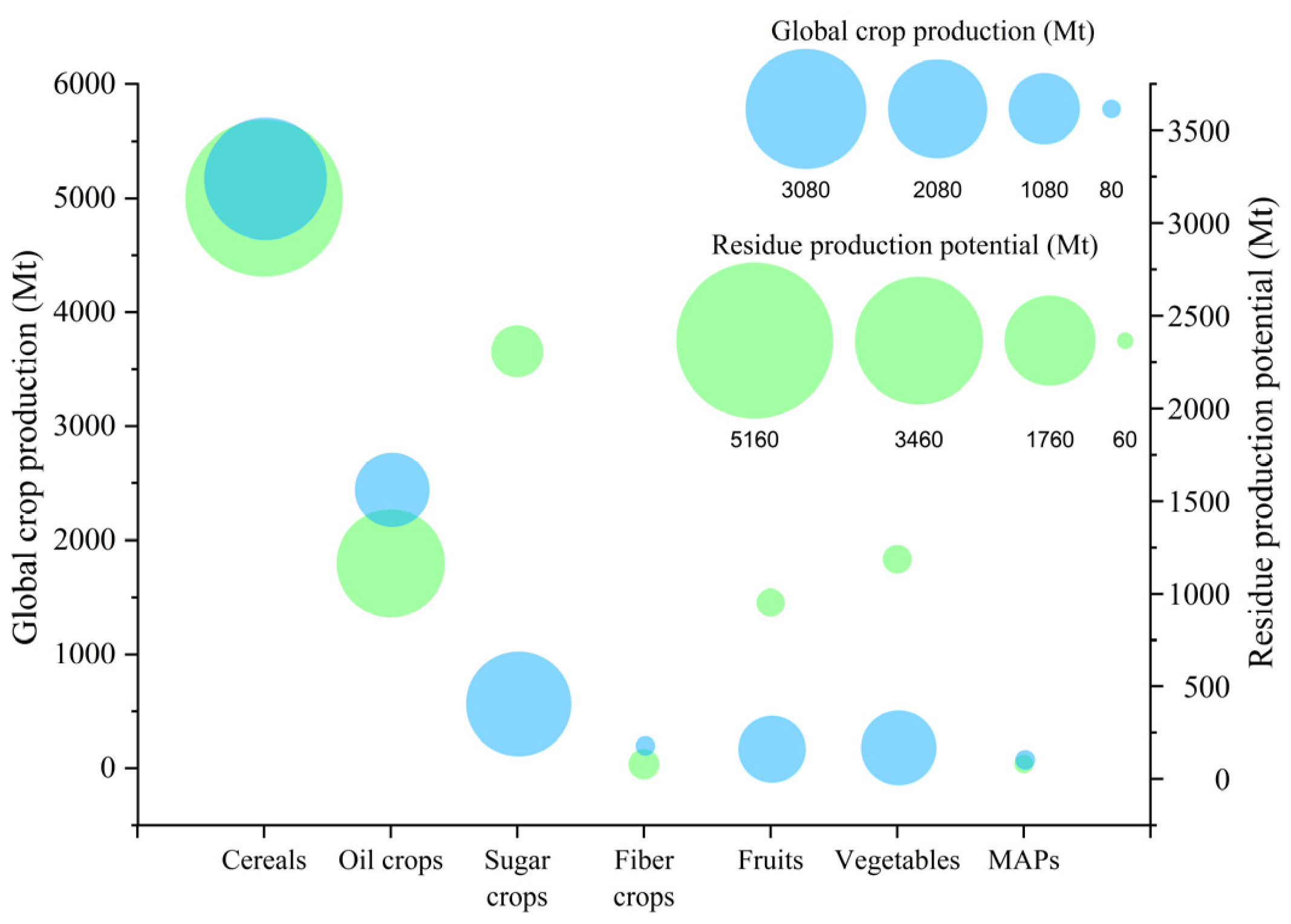
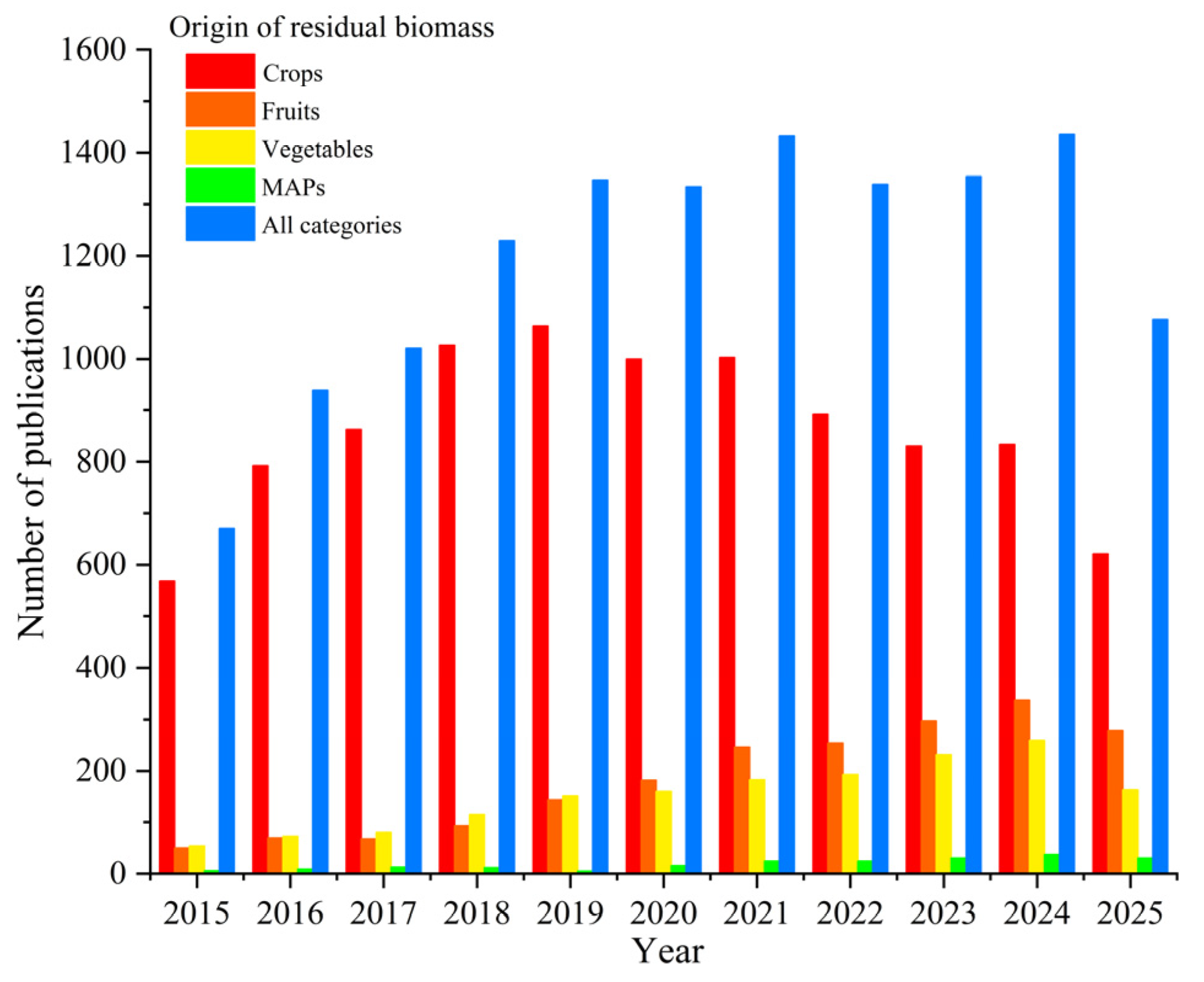
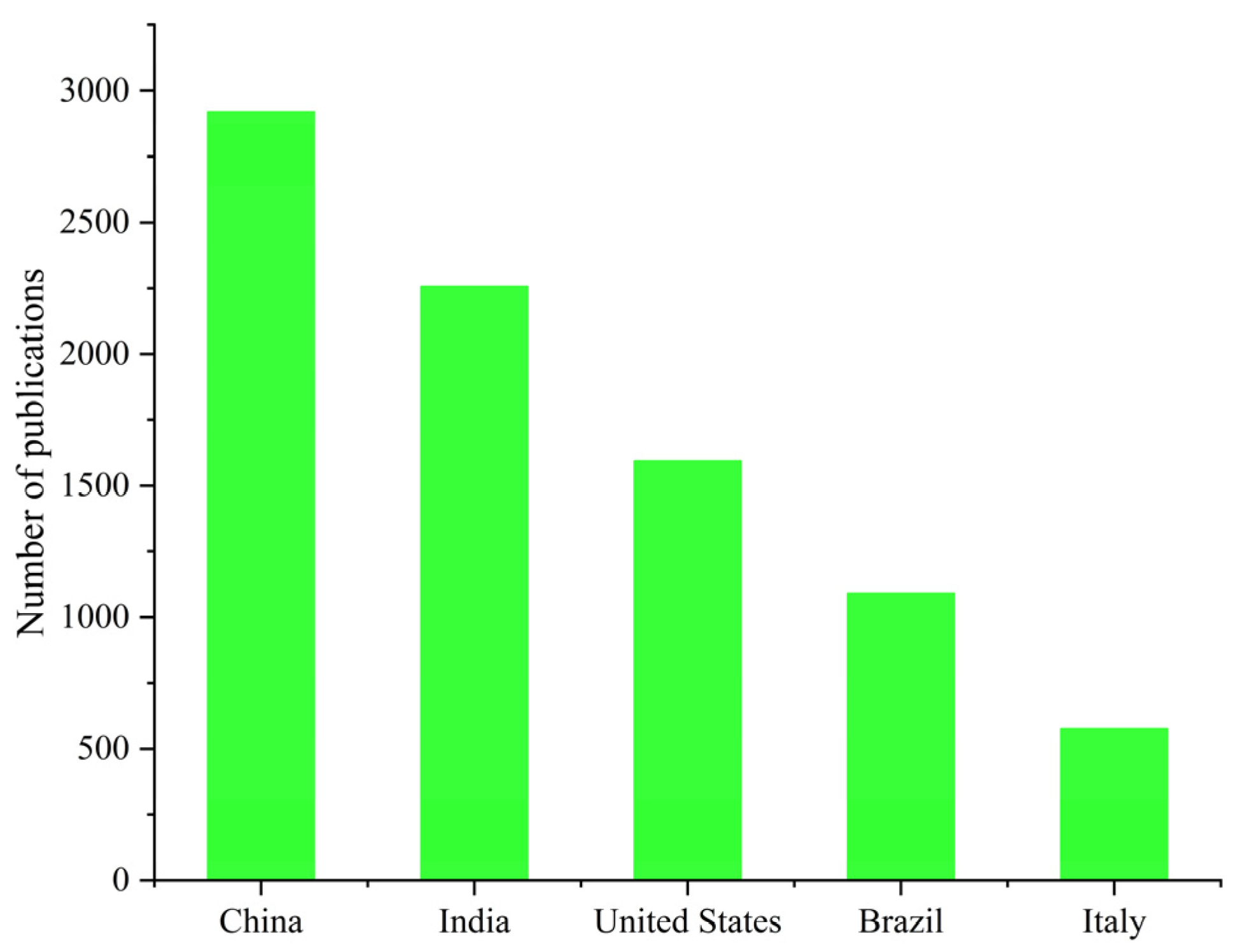
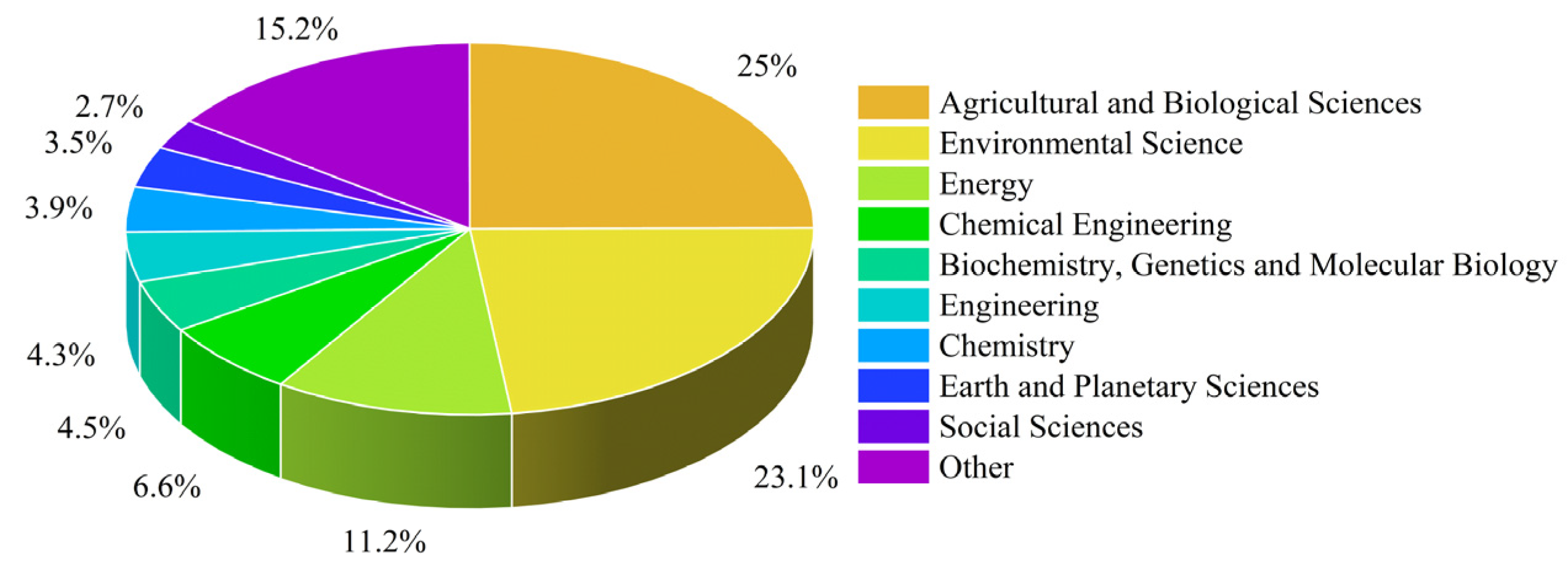
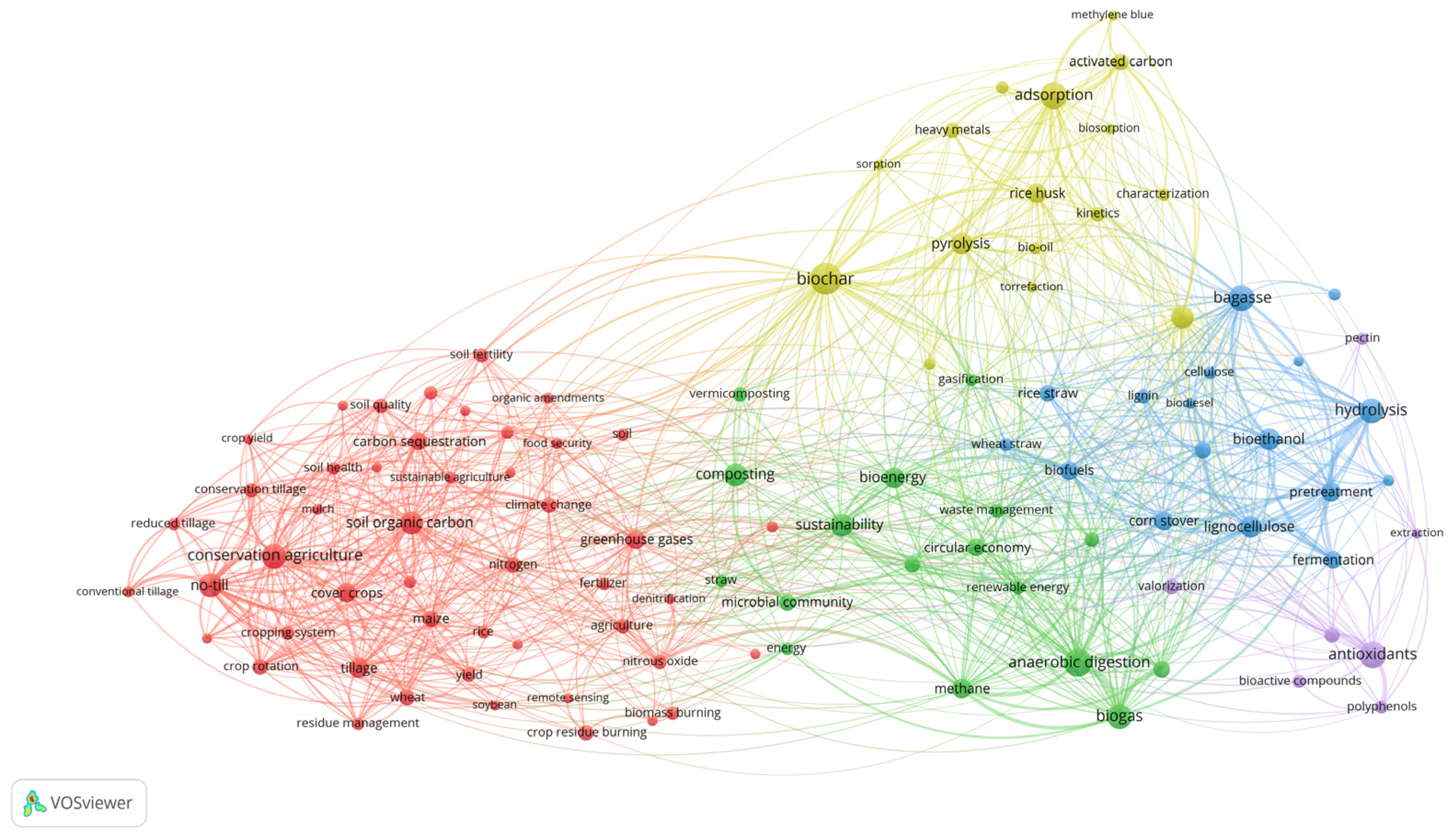
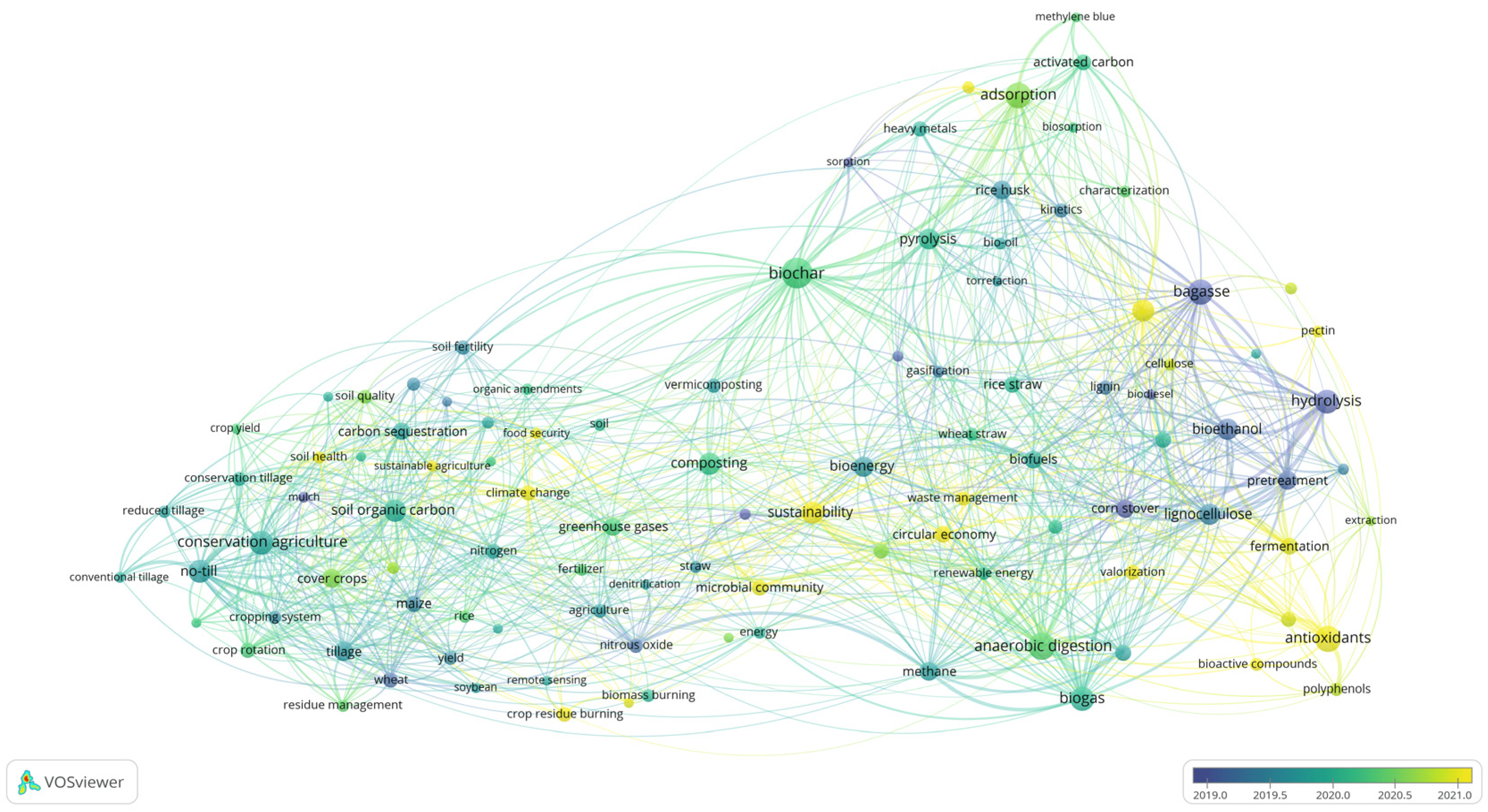
| Biomass | Processing Technology | Main Findings | Ref. |
|---|---|---|---|
| Corncob | Ultrasound + ternary DES |
| [28] |
| Powdered date fruit | Ultrasound |
| [29] |
| Corncob | Microwave + alkaline hydrogen peroxide |
| [34] |
| Sugarcane bagasse | Microwave + ChCl/lactic acid |
| [36] |
| Walnut shells | DBD plasma |
| [38] |
| Sugarcane bagasse | Cold plasma |
| [39] |
| Corn stalk | Cold plasma jet+ alkaline hydrogen peroxide |
| [40] |
| Corn stalk | Cold plasma jet+ Fenton process |
| [41] |
| Biomass | Green Solvent | Target Compounds | Main Findings | Ref. |
|---|---|---|---|---|
| Oil palm decanter cake | d-Limonene | Residual crude palm oil |
| [65] |
| Vegetable and nut seeds | d-Limonene | Vegetable and nut oils |
| [66] |
| Lotus leaves | Two-phase vortex-assisted extraction system (aqueous ammonia + d-limonene) | Nuciferine (alkaloid) |
| [67] |
| Olive leaves | Cyclodextrins/glycerin co-solvent | Polyphenols |
| [68] |
| Red grape pomace | Aqueous glycerol/tartaric acid | Polyphenols, flavonoids, pigments |
| [69] |
| Red grape pomace | Glycerol-based solvents | Antioxidant and pigment compounds (polyphenols, anthocyanins, etc.) |
| [70] |
| Carménère grape pomace | Water + glycerol | Polyphenols |
| [71] |
| Orange peel waste | Glycerol-based solvents | Polyphenols |
| [72] |
Disclaimer/Publisher’s Note: The statements, opinions and data contained in all publications are solely those of the individual author(s) and contributor(s) and not of MDPI and/or the editor(s). MDPI and/or the editor(s) disclaim responsibility for any injury to people or property resulting from any ideas, methods, instructions or products referred to in the content. |
© 2025 by the authors. Licensee MDPI, Basel, Switzerland. This article is an open access article distributed under the terms and conditions of the Creative Commons Attribution (CC BY) license (https://creativecommons.org/licenses/by/4.0/).
Share and Cite
Mladenović, D.; Grbić, J.; Tzani, A.; Bogdanović, M.; Detsi, A.; Radojčin, M.; Djukić-Vuković, A. Beyond Food Processing: How Can We Sustainably Use Plant-Based Residues? Processes 2025, 13, 3179. https://doi.org/10.3390/pr13103179
Mladenović D, Grbić J, Tzani A, Bogdanović M, Detsi A, Radojčin M, Djukić-Vuković A. Beyond Food Processing: How Can We Sustainably Use Plant-Based Residues? Processes. 2025; 13(10):3179. https://doi.org/10.3390/pr13103179
Chicago/Turabian StyleMladenović, Dragana, Jovana Grbić, Andromachi Tzani, Mihajlo Bogdanović, Anastasia Detsi, Milivoj Radojčin, and Aleksandra Djukić-Vuković. 2025. "Beyond Food Processing: How Can We Sustainably Use Plant-Based Residues?" Processes 13, no. 10: 3179. https://doi.org/10.3390/pr13103179
APA StyleMladenović, D., Grbić, J., Tzani, A., Bogdanović, M., Detsi, A., Radojčin, M., & Djukić-Vuković, A. (2025). Beyond Food Processing: How Can We Sustainably Use Plant-Based Residues? Processes, 13(10), 3179. https://doi.org/10.3390/pr13103179









